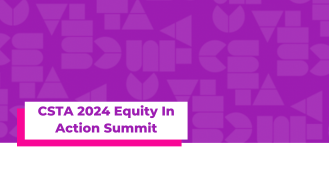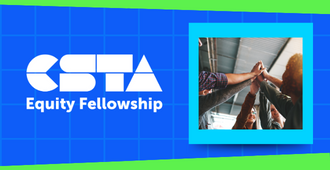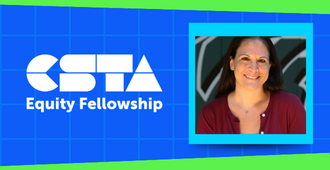In April, our Membership Experience Manager was able to speak with member Julie Alano. She is the Department Chair of Applied Sciences at Hamilton Southeastern High School in Fishers, Indiana. Julie is also an advisor of her school’s Computer Science Honor Society, founder and president of the CSTA Indiana Chapter, and heads girls track coach at the high school.
What has quarantine been like for you?
Personally, I think I’m fairing pretty well. I don’t have any children so it’s supporting myself and my husband at the moment. He’s a musician, so I’m finding a balance of hearing various instruments throughout the day and working. I recently stayed with my sister, who has a one-year-old. As both parents work, they are having a difficult time finding a balance. I’m sure it’s exhausting for those with kids trying to complete their own jobs while helping provide care and/or virtual learning.
How has your school schedule and calendar changed during the pandemic?
My school has moved to classes held three days a week on Tuesday, Wednesday, and Thursday. We have been doing this since April 14 and will end on May 21, so in total eight weeks of virtual learning. Fortunately, we were able to cut 20 days off the school year and extend our spring break to make this timeline work. My district asked teachers to give assignments so they are only 20-30 minutes each day, which has been a shift of what my normal lesson plans look like. In terms of support, I try to be available at most times via email to answer any questions or concerns the students have and provide zoom chats as well.
How prepared was your district to move to remote learning?
Actually we were in good shape to be able to do this. As a 1:1 district, we had already been doing e-learning for snow days. What is out of our control is the wireless internet connection, where some students may not have a great connection. We use Canvas as well as our learning management system, and it was a smooth transition to set up virtual teaching. We did not really get much time to prepare as our school closed on a Friday and we began virtual learning on Monday.
How has the balance been with teaching and checking in with students?
We are supposed to make sure that we check in with students to see if they have resources they need, or find out how we can connect them to these resources. If a teacher feels there’s an access issue, we are able to alert a support system at the school. Our schools have been doing well in this transition. I’m concerned about the students that have social and emotional needs in the classroom, and if they are getting support and their needs met at home.
What has worked for you in creating assignments that are manageable for students?
For daily assignments, cutting down on the information presented, and talking through various concepts to get students set up for success. I’m breaking down a regular classroom session into several days. Making videos of lessons has really been key for me, as I’m able to control the experience, and students can watch it in their own time. The videos are nice and concise around 20 minutes each, so it’s not overwhelming to the student. After a video session is sent out, the next day there is a follow up on the video, and assignments. I also use other resources like in CSP Code.org released a great video on the create task. I found a helpful
5-part series in the create task from Robert Tair to share with students.
This is a how-to video for scoring 100% on the AP Computer Science Principles Create Task. This series is divided into five parts to share with students. Setting up information that shows what students need to learn for assignments, and then providing extra materials if students want to continue learning. Some of the students are really interested in digesting more information. Another aspect that has been helpful is that I have a student-teacher assisting.
What resources are out there to help support students and teachers with AP tests?
The College Board has done a great job being transparent about changes and what to expect with exams. They have put out webinars about exam days, and students receive a check-list to help set them up for success. The exams themselves have been shortened. What’s great is there are a ton of resources to help support students with modified exams.
Some feedback we have seen from members is that there are far too many resources for teachers that have come out during the pandemic, what’s your perspective?
In speaking with other teachers through CSTA, honestly, teachers don’t even know what to look at at first. A lot of teachers have continued to keep using what they are used to. I have been using CodeHS free pro access and it has been quicker to access what’s needed which has saved time. By connecting with various Facebook groups for educators, we teachers are able to quickly assess a resource and share it. we are able to quickly assess a resource and share it. Code Academy was offering scholarships for students as well recently. There have been resources that I already knew about that are now free were most beneficial- stuff that my students or I were already using or knew about. I also started using Loom for screen recordings, which is now free forever for students and teachers.
How has your CSTA chapter been affected by the quarantine?
My chapter is actually still holding meet-ups by Zoom, and the last meeting we had someone talk about virtual reality (VR) robotics and other resources teachers may find helpful. We are actually trying to revamp things a bit with virtual meetings, and keep our regions divided so when we have in-person events again, members will be able to go.
What suggestions do you have for teachers for PD over the summer?
Summer is a great time to work on your skills. The CSTA conference is now virtual and will be a nice way to still connect with other educators. I actually attended my first CSTA conference in New York City in 2011. I work with Code.org as a facilitator, and many of their workshops will now be virtual, so perhaps easier for teachers to attend. What’s great, is as CS teachers, we do have a lot of free or low-cost resources that are available. Infosys is still hosting Pathfinders but virtually, and Carnegie Mellon University CS an Academy, has been reaching out to CSTA chapter leaders with a CS1 Python course virtual training.
Lessons learned:
-
Know your student audience. I’ve adjusted Zoom meetings to later in the day around 1 or 2 p.m., as students are staying up late and taking advantage of this time period. Understanding what your student’s needs and what’s best for them right now will help with your teaching. Not all teachers have this flexibility with timing, so do your best.
-
Manage and use the resources you have around you and figure out what’s the best way to move forward. Utilize your network by talking with other CS teachers. Get familiar with the learning management system (LMS) you are using and the variety of tools it provides.
-
Give students the ownership to learn things at their own pace. I plan to provide projects and information/enrichment for the summer so students have access to it. I am also trying to work with tech companies to connect with our students.
Anything else you would like to share?
Teachers know their students, and they know their classrooms best. Use what works, if there’s time and use the summer to find other resources. Don’t feel like you need to try new resources or let them overwhelm you with the latest and greatest during this difficult time. You are an expert teacher.




